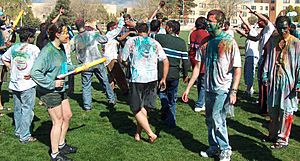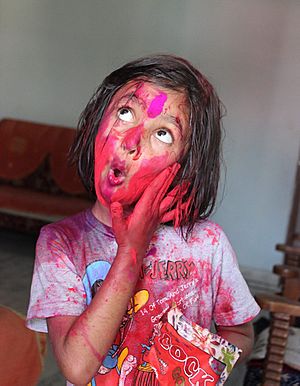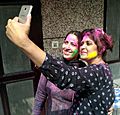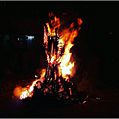Holi facts for kids
Quick facts for kids Holiहोली |
|
|---|---|
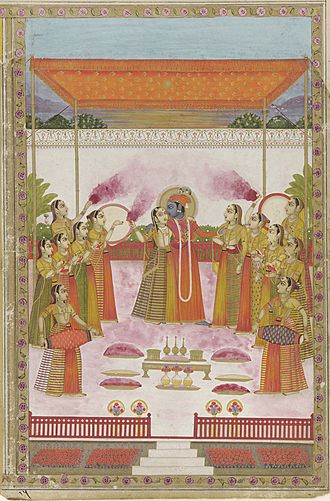
|
|
| Observed by | Predominantly Hindus, Sikhs, Jains, Newar Buddhists, and others |
| Type | Religious, cultural, spring festival |
| Celebrations | Night before: Holika Dahan, Kama Dahan On Holi: spraying colored dye, playing with colored powder, dancing, greetings, festival delicacies |
| Date | per Hindu calendar |
| Frequency | Annual |
Holi is a popular ancient Hindu festival, also known as the "Festival of Love", the "Festival of Colours", and the "Festival of Spring". The festival celebrates the eternal and divine love of Radha and Krishna. It also signifies the triumph of good over evil, as it celebrates the victory of Lord Vishnu as Narasimha Narayana over Hiranyakashipu. It originated and is predominantly celebrated in Nepal & India but has also spread to other regions of Asia and parts of the Western world through the diaspora from the Indian subcontinent.
Holi celebrates the arrival of spring, the end of winter, the blossoming of love and for many, it is a festive day to meet others, play and laugh, forget and forgive, and repair broken relationships. The festival also celebrates the beginning of a good spring harvest season. It lasts for a night and a day, starting on the evening of the Purnima (Full Moon Day) falling in the Hindu calendar month of Phalguna, which falls around middle of March in the Gregorian calendar. The first evening is known as Holika Dahan (burning of Demon Holika) or Chhoti Holi and the following day as Holi, Rangwali Holi, Dol Purnima, Dhuleti, Dhulandi, Ukuli, Manjal Kuli, Yaosang, Shigmo or Phagwah, Jajiri.
Holi is an ancient Hindu religious festival that has become popular among non-Hindus as well in many parts of South Asia, as well as people of other communities outside Asia. In addition to India and Nepal, the festival is celebrated by Indian subcontinent diaspora in countries such as Suriname, Guyana, Trinidad and Tobago, South Africa, Mauritius, Fiji, Malaysia, the United Kingdom, the United States, the Netherlands, Canada, Australia, and New Zealand. In recent years, the festival has spread to parts of Europe and North America as a spring celebration of love, frolic, and colours.
Holi celebrations start on the night before Holi with a Holika Dahan where people gather, perform religious rituals in front of the bonfire, and pray that their internal evil be destroyed the way Holika, the sister of the demon king Hiranyakashipu, was killed in the fire. The next morning is celebrated as Rangwali Holi (Dhuleti) – a free-for-all festival of colours, where people smear each other with colours and drench each other. Water guns and water-filled balloons are also used to play and colour each other. Anyone and everyone is fair game, friend or stranger, rich or poor, man or woman, children, and elders. The frolic and fight with colours occurs in the open streets, parks, outside temples and buildings. Groups carry drums and other musical instruments, go from place to place, sing and dance. People visit family, friends and foes come together to throw coloured powders on each other, laugh and gossip, then share Holi delicacies, food and drinks. In the evening, people dress up and visit friends and family.
Images for kids
-
The Mughal Indian emperor Jahangir celebrating Holi with ladies of the zenana.
-
Radha and the Gopis celebrating Holi, with accompaniment of music instruments.
-
The Holi Festival in March 2013 at the Sri Sri Radha Krishna Temple in Utah County, Utah.
-
An 1822 drawing showing elevation of a black stone arch in Puri, Odisha. It carried Vaishnavite gods and goddess, the ritual noted to be a part of the Holi festival.
-
Colours for Holi on sale at a market in Mysore
-
Holi celebrated at the Sri Sri Radha Krishna Temple in Utah, United States.
-
Colour drenched gopis in Krishna Temple, Mathura, India.
-
In the Braj region of North India, women have the option to playfully hit men who save themselves with shields; for the day, men are culturally expected to accept whatever women dish out to them. This ritual is called Lath Mar Holi.
-
Preparing for Holika Dahan, Kathamandu, Nepal.
-
Locals celebrating Holi in Kathmandu, Nepal.
-
Holi festival in London, UK near the Battersea Power Station.
See also
 In Spanish: Holi para niños
In Spanish: Holi para niños


